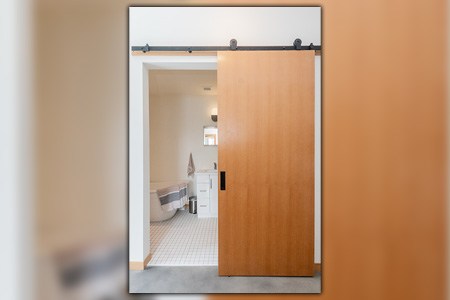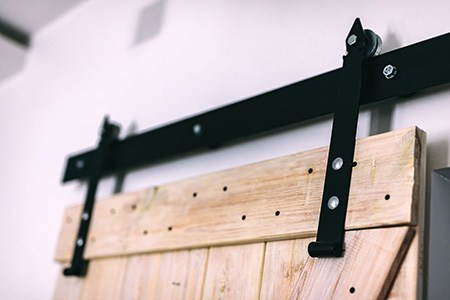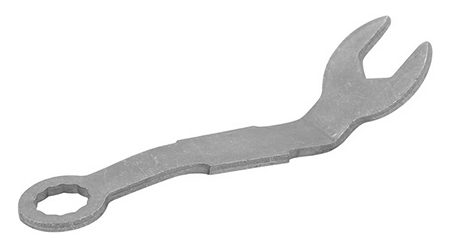How to Adjust Pocket Doors Easily & Correctly
Author: Rick Worst | Editor: Omar Alonso
Review & Research: Jen Worst & Chris Miller

Do you have pocket doors in your home? These doors have a pleasing aesthetic and are functional, but they often experience issues with opening and closing. One of the more common problems is getting the door to latch. Here we will teach you how to adjust pocket doors quickly and easily.
The locksets on pocket doors also present issues, with a minimal margin for error when lining up the door and the lock. The height of the door also plays a role in the correct attachment of the latch. Pocket door adjustment corrects these alignment and height issues.
This guide gives you everything you need to know on how to adjust a pocket door. We’ll give you tips and strategies for effective adjustment. Don't tear your hair out and wish you had pocket door alternatives. We'll get you through this annoyance fairly easily.
Troubleshooting Pocket Door Problems

You’ll need the door height to match the strike plate properly when adjusting the latch on the pocket door. If the catch doesn’t engage properly, it means the catch and strike plate aren’t aligned correctly. Position the door as close as possible to the strike plate, then work the lock and see if the tongue on the catch is too low or high.
The catch acts as a hook, holding the door closed when engaged. Keeping the door open is usually not a problem but sometimes these can start to roll shut a little bit and annoy you, too. If the pocket door is too low, it might scrape the floor, requiring you to raise it. You’ll need to be careful with this exercise, as too much shift in the door height can cause the door latch to fail to engage.
If there’s a gap in the side of the pocket door, adjusting it can get tricky. You’ll need to understand how the door moves when raising or lowering one side of the door. This is simply the trade-off for enjoying doors without any types of door hinges at all that don't take up extra space in the room.
Adjusting the Pocket Door Height

When people ask how to level a pocket door, they're really asking how to correct the height and an imbalance in the height. The method of installing a pocket door allows for the adjustment of its height, thankfully.
You can't adjust it as you would with a standard hinged door. You'll need a specialized pocket door wrench to make adjustments to the hangers, but we'll discuss more on the wrench later.
There's a narrow space at the top of the pocket door where the nut is on the hanger, and most pocket doors use a dual-hanger system. Turning this nut clockwise raises the door while turning it anti-clockwise lowers it.
When adjusting the height of the door, you'll want to turn each of the hanger nuts in the same direction and the same amount. If you don't follow this procedure, it results in a crooked door that doesn't close properly.
Give each hanger nut a full turn and check its impact on the door height. Continue turning the nuts to lower or raise the nuts to your desired height. Ensure you assess the door after adjusting it to see if it latches properly.
Please pay attention when raising or lowering the door, as it might affect the effective operation of the door latch. If you're adding new flooring, it might seem logical to raise the height of the pocket door. However, increasing it this much might cause problems with the correct engagement of the lockset. Trimming the material from the bottom is better than raising it.
Adjusting the Pocket Door Side Margin

Making side adjustments to a door requires a process different from what you might think. If the gap between the wall and the door is manageable, you'll only adjust one of the hangers, typically the one farthest from the latch.
The gap on the side of the pocket door is either at the bottom or the top. You'll raise the hanger farthest from the latch set if it's at the top. Use your pocket door wrench and give it a quarter to half turn at a time until you see the door get parallel with the jamb.
You'll need to do the opposite for gaps at the bottom. Lower the door by adjusting the hanger farthest from the door latch. This action causes the bottom of the door to shift toward the jamb, closing the gap. Keep using the strategy of a quarter or half turn until you get it in perfect alignment.
After correcting the margin, you'll need to make minor adjustments to the door height. Ensure you check the lockset operation and make the necessary adjustments for smooth operation. All of these steps are critical in the how to adjust pocket doors procedure and may require returning back and forth to each as you get them all closer to the ideal setting.
Problems with the Pocket Door Track & Rollers

Most of the time, you'll find the problem roller; the leading roller in the wall is the most challenging to reach. A lack of lubrication and worn or damaged roller wheels can cause pocket doors to malfunction. Use grease or spray lubrication like WD-40 to loosen up the rollers if they're dry or stuck.
Sometimes, the problem stems from manufacturing or installation problem. The contractor might use short screws or screws with fine threads that can't carry the door's weight effectively. Eventually, the threads or fasteners give way, affecting the normal operation of the pocket door.
It's common to find contractors using metal stud drywall screws when installing a pocket door. The threads might be long enough, but they're too fine and insufficient for holding the wood and securing the upper roller bracket to the door. This is a common problem in pocket doors that sit unused for years; they might fail when used more often.
There's a roller allowing adjustment by sliding the roller bracket down or up against the frame attached to the door, using a bolt to hold it in place. If it loosens up, it's usually hard to adjust without cutting a hole in the wall or disassembling the frame.
Loose bolts or screws securing a multi-track might cause sagging in the track or binding in the rollers. Typically, the bolts hit the rollers, derailing them. The track may loosen from supports within the pocket, causing rubbing in the floor, or there might be a distortion or bend.
Understanding Pocket Door Wrenches
A pocket door wrench is a dedicated tool for adjusting the height and width of a pocket door. This specialized wrench has a specific angle allowing for effective door alignment for these specific types of interior doors. The wrench features a flat, narrow design enabling it to fit in narrow, small openings.
It's the ideal tool for reaching the components of the pocket door that hide behind the door jambs and wood trim. Most models come with a universal design and work on all pocket doors. There are also pocket door adjustment wrenches featuring two heads. One side has a closed face for specific bolts, and the other is open-ended for adjusting larger bolts.
What Does a Pocket Door Wrench Do?
The pocket door wrench allows effective adjustment of the bolts, allowing you to move the hinges up or down. Turning clockwise raises the door, and turning it counter-clockwise drops the door height relative to the floor. When it comes to how to adjust pocket doors, you can use similar tools but these are designed in such a way that they're easier to use and will save you time.

Above is an example of a pocket door wrench. They will typically be combination wrenches, meaning they have an open end and a box end (the circular side). Some will feature a 45 degree angle to help you reach into the gaps in the frame while others will be straight with no curvature.
Size of Pocket Door Wrenches
While most pocket doors have universal hardware, you might find some models that require a specialized pocket wrench. Each manufacturing brand delivers its pocket doors with hardware; some might have different hardware than others.
The hardware kit included with the door should feature a track, rollers, hangers, framing members, and a header assembly. They'll usually include a pocket door wrench with the hardware, allowing for complete installation without having to source a wrench from another supplier.
Each pocket door manufacturing brand will often produce a different pocket wrench design. This strategy ensures you must purchase hardware and spares from the manufacturing brand, or you risk spending more on an entire kit and the hassle of replacing all the hardware to match the pocket door wrench.
It's easy to misplace your pocket door wrench. If so, you'll have to purchase a hardware kit from the same manufacturing brand or contact their customer support department for a spare wrench. If you don't know the name of the manufacturing brand, look for stamps on the hardware, they'll usually display the manufacturer's name.
Typically, pocket doors require adjustment and maintenance every six to nine months, depending on the frequency of use. You'll need to check the track for debris and lubricate the rollers and track for smooth operation. Feel free to bookmark this page to return to in the future if needed or search "how to adjust pocket doors" to find us or other tutorials.
FAQ's on Adjusting Pocket Doors

There are some common questions that arise when discussing the adjustment of pocket doors. Let's tackle those now so everyone will have the answers.
Is There a Tool for Adjusting Pocket Doors Other Than a Pocket Door Wrench?
If you can't find your pocket wrench and don't know which manufacturing brand produced the door, try using needle-nose pliers to make adjustments. Most standard wrenches are too thick to fit into the tight space and aren't effective for maintaining pocket doors.
Or you can remove the pocket door from the track and adjust it using a standard wrench. However, pulling the door off the track with each adjustment is frustrating.
What are the Typical Problems Experienced With Pocket Doors?
Pocket doors are well-known for causing problems with opening, closing, and sticking latches. Over time the door might fall off the tracks, get stuck, screech when opening and closing, or become hard to lock. Sometimes, you'll need to tighten the bolt to lift and adjust the door. A pocket door wrench is essential for these tasks to avoid the hassle of removing the door from the hinges.
Can I Get Online Support From Pocket Door Manufacturers?
Most pocket door manufacturing brands have help centers or online service teams that assist with getting you the hardware you need to maintain and repair your pocket door. They'll also have online instructional videos to help you visualize maintenance tasks.
That's How to Adjust Pocket Doors the Right Way
Pocket doors are such a pleasure to have and use when they work right. Over time, you'll have problems with their alignment, causing more issues on their tracks and with them rubbing against their frames, and more. Know that you know how to adjust pocket doors, you can say goodbye to all of that and hello to the amazing experience you knew from the start.



